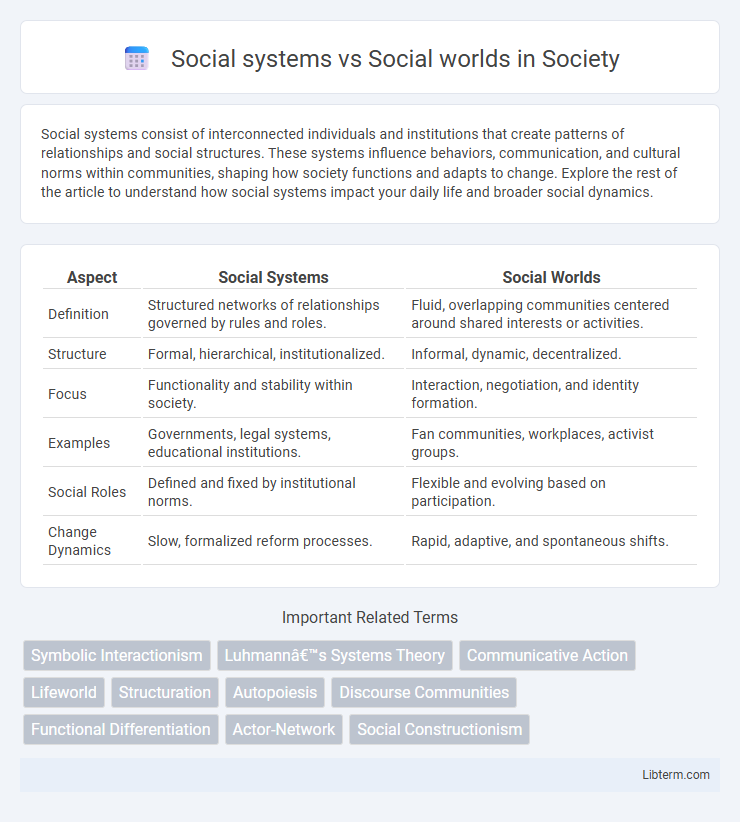Social systems consist of interconnected individuals and institutions that create patterns of relationships and social structures. These systems influence behaviors, communication, and cultural norms within communities, shaping how society functions and adapts to change. Explore the rest of the article to understand how social systems impact your daily life and broader social dynamics.
Table of Comparison
| Aspect | Social Systems | Social Worlds |
|---|---|---|
| Definition | Structured networks of relationships governed by rules and roles. | Fluid, overlapping communities centered around shared interests or activities. |
| Structure | Formal, hierarchical, institutionalized. | Informal, dynamic, decentralized. |
| Focus | Functionality and stability within society. | Interaction, negotiation, and identity formation. |
| Examples | Governments, legal systems, educational institutions. | Fan communities, workplaces, activist groups. |
| Social Roles | Defined and fixed by institutional norms. | Flexible and evolving based on participation. |
| Change Dynamics | Slow, formalized reform processes. | Rapid, adaptive, and spontaneous shifts. |
Defining Social Systems: Structure and Function
Social systems consist of organized structures of interrelated roles and institutions that maintain stability and coordinate collective behavior through established rules and norms. Their function is to regulate interactions, facilitate communication, and enable cooperation among members to achieve shared goals within a defined environment. These systems are characterized by hierarchical organization and systemic feedback mechanisms that sustain social order and adaptability.
Understanding Social Worlds: Meanings and Dynamics
Social worlds represent the shared meanings, practices, and interactions that define groups, emphasizing how individuals co-construct reality through language and symbols. Unlike rigid social systems, social worlds are dynamic, evolving with ongoing negotiations and collective experiences that shape identities and norms. Understanding these social worlds requires analyzing communicative processes and the fluid boundaries that allow members to belong and participate actively.
Key Differences Between Social Systems and Social Worlds
Social systems are structured networks of interrelated roles and institutions governed by formal rules and hierarchies, while social worlds are dynamic, fluid collective spaces formed through shared interests, practices, and meanings among individuals. Social systems emphasize organization and stability within society, whereas social worlds highlight the process of social interaction and identity construction. The key difference lies in social systems being more rigid and systemic, whereas social worlds capture the evolving and interpretive nature of social life.
Historical Evolution of Social Systems and Worlds
Social systems have evolved through structured institutions and established roles shaping societal functions over time, while social worlds emerge from fluid, overlapping group interactions and shared meanings. The historical evolution shows social systems solidifying with industrialization and governance frameworks, whereas social worlds adapt dynamically with cultural shifts and technological innovations. Understanding these distinctions highlights the interplay between formal social order and informal community networks in shaping human behavior.
Theoretical Foundations: Luhmann vs Schütz
Niklas Luhmann's theory of social systems emphasizes communication as the fundamental element, viewing society as a complex network of self-referential systems that operate autonomously through communicative processes. In contrast, Alfred Schutz's concept of social worlds centers on the shared meanings and experiences of individuals within lifeworlds, highlighting the subjective construction of social reality through intersubjective interactions. The theoretical divergence lies in Luhmann's systemic, communication-based approach versus Schutz's phenomenological, meaning-centered perspective on social phenomena.
Interactions within Social Systems
Social systems are structured networks of interrelated individuals and institutions governed by formal rules and roles, while social worlds represent fluid, shared cultural environments shaped by common interests and meanings. Interactions within social systems involve organized communication and role-expectation fulfillment, facilitating stability and coordinated behavior among members. These interactions are critical for maintaining system cohesion, enabling predictability, and supporting goal-oriented social processes.
Shared Realities in Social Worlds
Social worlds are characterized by shared realities that emerge through collective meanings, practices, and interactions within specific communities, whereas social systems refer to structured institutions and formal relations. Shared realities in social worlds allow individuals to negotiate identities, norms, and values dynamically, fostering a sense of belonging and mutual understanding. These shared realities differ from the rigid roles and hierarchies found in social systems, emphasizing fluidity and cultural significance over fixed organizational functions.
Overlaps and Intersections: Where Systems Meet Worlds
Social systems, structured networks of roles and institutions, intersect with social worlds, the fluid, interaction-based cultural milieus where meaning is co-created. Overlaps occur when institutional frameworks influence or are shaped by everyday social practices and shared understandings within social worlds. These intersections highlight the dynamic interplay between formal organization and lived experience, revealing the complex fabric of social reality.
Implications for Modern Society
Social systems represent structured, organized frameworks like institutions and governments that regulate behavior and maintain order, while social worlds consist of fluid, overlapping networks of shared meaning among groups or communities. Understanding the dynamic interplay between rigid social systems and adaptable social worlds reveals complexities in addressing social change, identity formation, and conflict resolution in modern society. This distinction highlights the need for flexible policies that accommodate diverse social experiences and support inclusive participation.
Future Perspectives on Social Organization
Future perspectives on social organization emphasize the dynamic interplay between social systems, defined by structured institutions and formal roles, and social worlds, characterized by fluid, emergent networks of shared meanings and experiences. Advances in technology and digital communication platforms are reshaping social worlds into increasingly decentralized and participatory environments, challenging traditional social systems to adapt through flexible governance and collaborative frameworks. Understanding this evolving relationship is crucial for developing resilient social organizations that balance stability with innovation in an ever-changing global landscape.
Social systems Infographic

 libterm.com
libterm.com